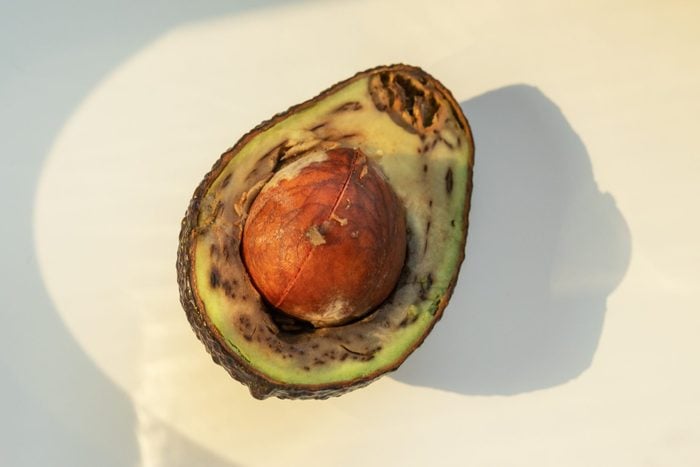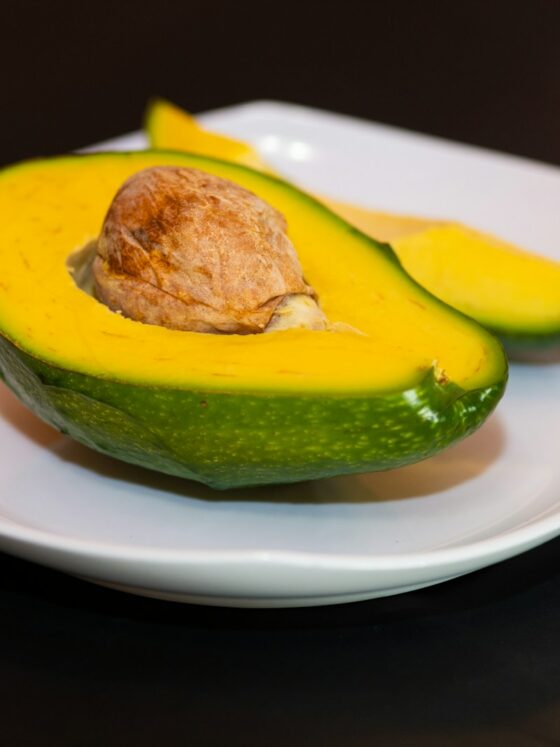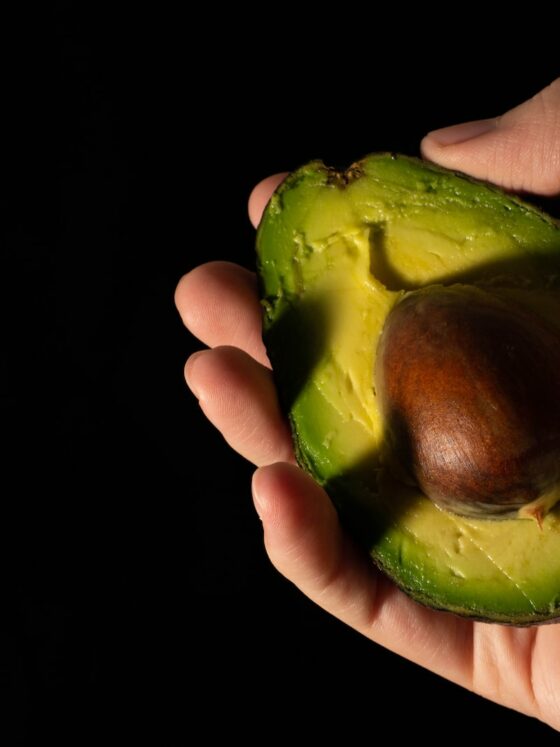Avocados are a popular fruit that is loved for its creamy texture and rich flavor. However, it can be difficult to know when an avocado has gone bad. Eating a rotten avocado can lead to an upset stomach, so it’s important to know how to tell if an avocado is bad before consuming it.
One of the most important things to consider when determining if an avocado is bad is its ripeness. A ripe avocado should have a slight give when gently squeezed, but it should not be overly soft or mushy. An overripe avocado will often have brown spots on the flesh and may have a stringy texture. On the other hand, an unripe avocado will be hard and difficult to cut open.
Proper storage is also key to keeping avocados fresh for as long as possible. Avocados should be stored at room temperature until they are ripe, at which point they can be stored in the refrigerator for a few days. However, if an avocado is already overripe, it should be used as soon as possible or discarded. By knowing how to tell if an avocado is bad, you can avoid consuming a rotten fruit and enjoy all the benefits of this delicious and nutritious fruit.
Table of Contents
Identifying Ripe and Overripe Avocados
When it comes to avocados, it can be tricky to tell when they are ripe and ready to eat, or when they have gone bad. Here are some tips for identifying ripe and overripe avocados.
Assessing Color and Skin Texture
The skin color and texture of an avocado can give you some clues about its ripeness. Hass avocados, which are the most common variety, start out with a dark green, almost black skin. As they ripen, the skin will turn a lighter shade of green and may develop brown spots. However, if the skin is blackened or has large brown spots, the avocado may be overripe.
In addition to the skin color, the texture of the avocado’s skin can also be an indicator of ripeness. A ripe avocado will have a slightly soft, but firm skin. The skin should yield slightly to pressure, but should not feel overly soft or mushy. On the other hand, an overripe avocado will have an overly soft skin that may show signs of indentation or bruising.
Feeling for Firmness
Another way to determine if an avocado is ripe is to feel for firmness. When gently squeezed, a ripe avocado will feel firm but will give slightly to pressure. If the avocado feels overly soft or mushy, it may be overripe.
Checking the Stem
The stem of an avocado can also provide some clues about its ripeness. If the stem is still attached to the avocado, gently try to remove it. If it comes off easily and you can see green underneath, the avocado is likely ripe. If the stem is difficult to remove or if you see brown underneath, the avocado may be overripe.
In summary, when assessing an avocado’s ripeness, look for a bright green skin that is slightly soft but still firm to the touch. Avoid avocados with blackened skin, large brown spots, or overly soft or mushy flesh. By following these tips, you can ensure that you are selecting the best avocados for your meals.

Detecting Spoilage in Avocados
Avocados are a delicious and nutritious fruit, but they can quickly spoil if not stored properly. Here are some tips to help you detect spoilage in avocados.
Noticing Bad Smells
One of the first signs that an avocado has gone bad is a bad smell. If you notice a rancid or sour odor coming from the avocado, it may be spoiled. In some cases, the smell may be so strong that it is immediately apparent.
Looking for Mold and Decay
Mold and decay are also signs that an avocado has gone bad. Mold can appear as fuzzy gray or black spots on the skin or flesh of the avocado. Decay can cause dark streaks or discolored areas on the surface of the avocado. If you notice any mold or decay, it’s best to discard the avocado.
Examining the Flesh
When examining an avocado for spoilage, it’s important to examine the flesh. If the flesh has a stringy or fibrous texture, it may be a sign that the avocado is overripe or spoiled. Bruising can also cause the flesh to become discolored or stringy. If you notice any of these signs, it’s best to discard the avocado.
In conclusion, detecting spoilage in avocados is important to ensure that you are consuming a safe and healthy fruit. By following these tips, you can easily detect signs of mold, decay, and bad smells, and avoid consuming a bad avocado.

Proper Storage and Handling of Avocados
Avocados are a delicious and nutritious fruit, but they can be tricky to store and handle properly. Here are some tips to help you keep your avocados fresh and delicious.
Ripening and Storing Techniques
Avocados are typically sold unripe in the market. To ripen an avocado, store it at room temperature until it is ripe. If you want to speed up the ripening process, put the avocado in a brown paper bag with an apple or a banana. The ethylene gas produced by the apple or banana will help the avocado ripen faster. Once the avocado is ripe, you can store it in the fridge to extend its shelf life. If you have unripe avocados and you want to accelerate the ripening process, wrap them in newspaper or place them in a brown paper bag with the top tightly closed. Then place the avocados in a warm area, such as next to the stove. Avoid putting them in the refrigerator, as this will delay ripening.
Extending Freshness After Cutting
Once an avocado is cut, it begins to oxidize, which causes it to turn brown and spoil. To prevent this, brush the cut surface with lemon juice or vinegar, which will help prevent oxidation. Then wrap the cut avocado tightly in plastic wrap or aluminum foil, making sure there is no air inside the wrapping. Store the wrapped avocado in the fridge until you are ready to use it. Alternatively, you can store the cut avocado in an airtight container with a slice of onion, which will also help prevent oxidation.
Storing avocado in the fridge can also help extend its freshness after cutting. If you have leftover avocado, store it in an airtight container in the fridge. If you want to freeze avocado, cut it into chunks or mash it and place it in an airtight container or freezer bag. Add a squeeze of lemon juice to help prevent oxidation. Frozen avocado can be used in smoothies or other recipes that call for mashed avocado.
By following these simple tips, you can ensure that your avocados stay fresh and delicious for longer.
Using Avocados in Various Dishes
Avocados are versatile fruits that can be used in a variety of dishes. They are perfect for making guacamole, adding to salads, smoothies, toast, and even baked goods. In this section, we will discuss some of the ways to prepare avocados and how to conduct a taste test to ensure that they are ripe and ready to use.
Preparing Avocado-Based Recipes
When preparing avocado-based recipes, it is important to start with ripe avocados. Ripe avocados are soft to the touch and have a creamy texture. To prepare avocados, cut them in half, remove the pit, and scoop out the flesh. Mashed avocados are perfect for making guacamole, while sliced or diced avocados can be added to salads or used as a topping for toast.
Avocado can also be used to make salad dressing. To make a simple avocado dressing, blend ripe avocado with olive oil, lemon juice, salt, and pepper until smooth. This dressing is perfect for drizzling over salads or roasted vegetables.
Conducting a Taste Test
Before using avocados in a recipe, it is important to conduct a taste test to ensure that they are ripe and ready to use. To conduct a taste test, cut the avocado in half and remove the pit. Taste a small piece of the avocado to determine if it is sweet and has a nutty flavor. If the avocado tastes bland or has a bitter flavor, it may not be ripe.
In addition to taste, it is also important to check the texture of the avocado. Ripe avocados should be soft to the touch, but not mushy. If the avocado is too hard, it is not ripe, while a mushy avocado is overripe and should not be used.
In conclusion, avocados are a versatile fruit that can be used in a variety of dishes. When preparing avocado-based recipes, it is important to start with ripe avocados. Conducting a taste test can help ensure that the avocado is ripe and ready to use.












